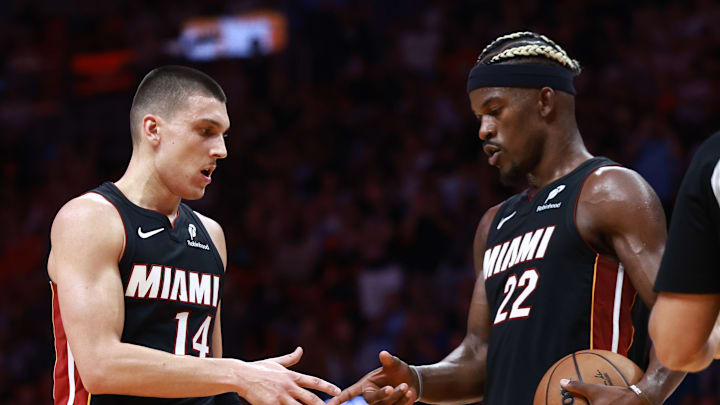All Jimmy Butler could do was laugh and rub the bridge of his nose.
“That’s crazy,” he said while looking down at a box score print-out on the postgame podium after Monday night’s 111-110 loss to the Sacramento Kings.
Crazy is one way to put it. The Miami Heat won all but one quarter, out-scoring the Kings by a total of 19 points in the first, second and fourth quarters, but lost the third quarter by 20 (37-17).
This has been a trend for the Heat, who dropped to 3-3, through the first two weeks of the season. In six games, the Heat have out-scored their opponents by 17 points in the first quarter, 25 points in the second and 17 in the fourth, but have lost the third quarter by a combined 52 points.
Subtract the third period, and Miami’s point differential would rank behind only the Oklahoma City Thunder, Golden State Warriors, Cleveland Cavaliers and Boston Celtics.
Crazy stat:
— Wes Goldberg (@wcgoldberg) November 5, 2024
Heat's total scoring margins by quarter this season
1Q: +17
2Q: +25
3Q: -52 🤮
4Q: +17
Subtract the 3Q and the Heat are outscoring opponents by 9.8 points per game.
Coach Erik Spoelstra didn't offer a solution when asked about the third-quarter issues after the game.
“We have to figure it out,” Spoelstra said.
Butler had his theory.
“When we ain’t making shots, that’s when the other team goes on runs,” Butler said. “We don’t get back, we don’t defensive rebound. It is a defensive thing, but for us, it’s more offensive. When we don’t see the ball go through that basket, I think that, mentally, we have to be stronger and tougher to still get stops. That’s the main problem, and that’s what you’re seeing in the third quarter.”
The Heat have to solve their third-quarter issues in time for a difficult six-game trip.
Butler has a point. The Heat’s struggles in the third quarter can be traced to their 3-point shooting percentage. The Heat are remarkably consistent in the first, second and fourth quarters, shooting 41% or better each period. But, for some reason, they come out cold to start the second half and have made just 29.5% (18 of 61) of their 3s in the third quarter.
While some could point to the various extended halftimes to celebrate Pat Riley, Dwyane Wade and Bam Adebayo as a reason for falling out of rhythm, it doesn’t explain Miami’s opponents – who have to deal with the same halftime – shooting nearly 40% in the third quarter.
To Butler’s point, there may be a snowball effect. The Kings shot 68.2% in the third quarter on Monday night. A lot of those shots were well-contested, but there were also some uncharacteristic lapses on defense.
The Heat, meanwhile, had some uncharacteristic misses.
Some of this is undoubtedly a chance version of small-sample theatre, like getting tails on a coin flip 20 times in a row. But the Heat can’t merely hope for an eventual reversion to the mean.
On Wednesday, the Heat will embark on the most challenging part of their schedule, a stretch that could define their season.
The Heat begin a six-game trip starting Wednesday in Phoenix against the 6-1 Suns. From there, they head to Denver, Minnesota, Detroit and Indiana (for two games). When the Heat return later this month, they will host the Philadelphia 76ers (with Paul George and maybe Joel Embiid), Dallas Mavericks and Milwaukee Bucks.
That’s eight of nine games against teams that made the playoffs last season. The Heat are currently 0-3 against last season’s playoff teams and haven’t won a regular-season game against a team with a winning record since April 2.
This reflects an issue that dogged the team last season, when they were 5-20 against opponents with a top-10 point differential.
To make a deep playoff run, the Heat need to beat good teams. So far this season, it’s looked like last season: beating up on the bad teams while losing to the good ones.
If the Heat can’t buck the trend and go 1-5 on this trip, they’ll fall to 4-8 on the season. By Thanksgiving, they could be five, six or seven games under .500.
At that point, it’s fair to wonder what happens. Will Spoelstra pull the plug on a starting lineup that has been out-scored by 33 points this season? Will they consider becoming sellers at the trade deadline? Or will Jimmy Butler’s name make headlines like Giannis Antetokounmpo is now?
These potential outcomes and Miami’s required sense of urgency are very real. These next nine games will reveal whether the Heat are good enough to compete in the East or if the window for this group is closed.
There are plenty of factors that indicate the Heat are a good team, but digging a hole to start every second half is an easy way to torpedo their chances at contending.
“There’s not much to talk about at this point. It’s about the third quarters,” Tyler Herro said. “It’s been a trend for us all year, so we gotta figure it out.”
